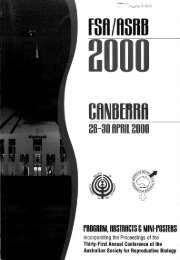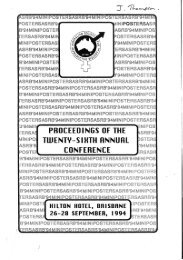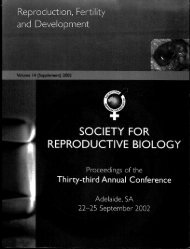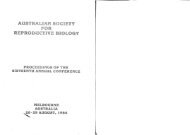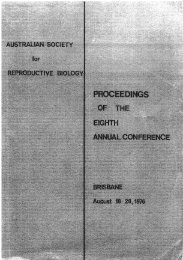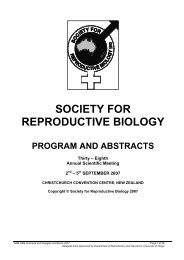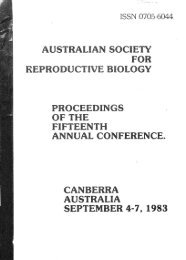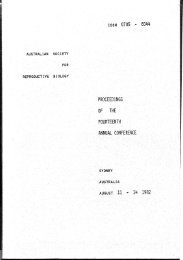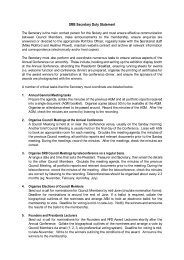N OCIETY' - the Society for Reproductive Biology
N OCIETY' - the Society for Reproductive Biology
N OCIETY' - the Society for Reproductive Biology
Create successful ePaper yourself
Turn your PDF publications into a flip-book with our unique Google optimized e-Paper software.
Controlled Breeding of Lactating Cycling Dairy CowsVK Taufa, KL Macmillan!, G Verkerk, SR Morgan,AM Day, R Hooper .Dairying Research Corporation, Private Bag 3123, Hamilton, NZ. I School of Veterinary Science, University of Melbourne, 250Princes Highway, Werribee, Victoria, Australia 3030.IntroductionPrevious trials in heifers achieved a high submission rateof 94% with comparable conception rate of 62% on <strong>the</strong>1st day of insemination by extending <strong>the</strong> CIDR insertionperiod from 7 to 8 days, with an oestradiol benzoate(ODB) injection at 24h after CIDR removal (1, 2). Theapplication of this system to cycling dairy cows withincorporation of two resynchrony treatments to condense<strong>the</strong> submission of cows returning to 1st or 2 ndinseminations could reduce whole herd inseminations to aperiod ofless than 14 days over 3 synchrony periods.AimTo improve <strong>the</strong> efficacy of a whole herd synchronyprogramme <strong>for</strong> use in seasonally-bred dairy herds.Materials & MethodsPre-mating heat records and/or ovarian palpation wereused to identify cycling cows (CC) in 10 commercialdairy herds. The CC cows were all treated with aprogesterone releasing intravaginal insert (CIDRTM,InterAg, Hamilton, NZ) <strong>for</strong> ei<strong>the</strong>r 7 days or8 days (7-dCC; 8-d CC) with 2mg ODB injected i.m (OestradiolBenzoate, Intervet, Auckland, NZ) at insertion (-d9).At insert removal (-d2 and -d1 <strong>for</strong> <strong>the</strong> 7-d CC and 8-d CCtreatments, respectively), each cow was given an i.m.injection of 500~g prostaglandin (PGF; cloprostenol,Estroplan, Parnell Laboratories, Auckland, NZ).At dO, any cow that had not been seen in oestrus, asdetermined by tailpaint removal, was given an Lm.injection of 1mg ODB (CIDIROLTM, InterAg, Hamilton,NZ). The cows were inseminated on detection of oestrusfrom dO. Those cows which had been inseminated fromdO-d2 were resynchronised with <strong>the</strong> previously usedCIDR inserts. These were reinserted at d13 <strong>for</strong> 7 days,with half of <strong>the</strong> animals allocated randomly at reinsertionto receive an i.m. injection of 1mg ODB. Any cowreturning to oestrus was inseminated on detection from48h after insert removal (d22). Cows which wereinseminated from d22-d24 received a fur<strong>the</strong>r i.m.injection of Img ODB on d35, and were inseminated ifdetected in oestrus.Bulls joined <strong>the</strong> herds from around d46. Individualconception dates and pregnancy were confirmed by rectalpalpation of <strong>the</strong> uterine contents 8 weeks after <strong>the</strong> firstround of AI, and again, 8 weeks after <strong>the</strong> bulls wereremoved from <strong>the</strong> herd.Results and DiscussionThere were no differences in submission (SR) andconception (CR) rates over <strong>the</strong> first 4 days <strong>for</strong> ei<strong>the</strong>r <strong>the</strong>7-d CC or ilie 8-d CC cows but <strong>the</strong> submission patternwas significantly different (Table 1). On dO, only 13% of<strong>the</strong> 7-d CC cows were inseminated compared to 81 % <strong>for</strong><strong>the</strong> 8-d CC cows (p < 0.001). The cumulative figureswere 91 % and 97%, 95% and 97%, <strong>for</strong> <strong>the</strong> 7-d and 8-dCC cows respectively, <strong>for</strong> d1and d4.128The PR of cows inseminated on dO also differed (5%vs 41 %; p < 0.001, <strong>for</strong> <strong>the</strong> 7-d CC and 8-d CC cowsrespectively), but <strong>the</strong> cumulative PR were similar by d4.Of <strong>the</strong> cows that had <strong>the</strong>ir returns synchronised to 2 ndinseminations, 84% were inseminated from d22-d24. TheODB at CIDR reinsertion improved <strong>the</strong> submission rate(57%) compared to those cows that received No ODB(43%). Similarly, injecting ODB atd35 gave a partialsynchrony, with 90% of those cows returning to 3rt!inseminations, bred from d41-d46.There were no effects of ODB treatment on <strong>the</strong> CRof cows with returns synchronised to till inseminations(53% vs 55% <strong>for</strong> ODB, No ODB treatments,respectively). The CR of cows which received ODB atd35 was 55%.Table 1: SR, CR and PR on dO and cumulatively to d4,d24 or d46, and mean interval from planned start ofmating (PSM) to 1st inseminations and to day ofconceptIOn.Variable 7-dCC 8-d CCn 973 923% %dOSR 13 81IdSR 91 954dSR 97 97dOCR 38 491dCR 55 484dCR 51 4822d-24d CR 48 5841d-46d CR 48 55OdPR 5 414dPR 50 4724dPR 68 6846dPR 79 81Final PR 88 91Intervals (d)PSM-1 sl Insem. 1 2PSM-Concept. 17 18ConclusionsThe extra day of progesterone pnmmg and reducedinterval from CIDR removal to ODB injection, allowed80% of <strong>the</strong> cows to be inseminated on dO but <strong>the</strong> oestrous.s:ynchrony was not significantly precise <strong>for</strong> set-timeinsemination of all cows. The modifications applied towhole herd synchrony programme enabled 80% of <strong>the</strong>cows to be pregnant to AI over 3 synchrony periods.AcknowledgmentsThe authors thank <strong>the</strong> farmers <strong>for</strong> <strong>the</strong> use of <strong>the</strong>ir animals,InterAg <strong>for</strong> <strong>the</strong>ir support with CIDR and CIDIROL,Intervet <strong>for</strong> Oestradiol Benzoate, Parnell Laboratories <strong>for</strong>PGF and DRC staff <strong>for</strong> <strong>the</strong>ir generous help.References1. Day, M.L., et al. (1997). Proc. Aust. Soc. Reprod. BioI.28:101.2. Taufa, V.K., Macmillan, K.L., et al. (1998). Proc. Aust.Soc. Reprod. BioI. 29:18.SHEEP EMBRYOS VIABLE AFTER 13 YEARS STORAGEN. M. Fogarty, W.M.C. Maxwell l , J. Eppleston 2 and G. Evans lAgricultural Institute, Orange NSW 2800, lUniversity of Sydney, NSW 2006 and 2PO Box 20,Bathurst NSW 2795IntroductionFrozen embryo technology has been used to importnew genetic material with embryos successfullytransferred up to a year after freezing (1). It can alsobe used <strong>for</strong> long-term maintenance of geneticresources, such as selection and/or control lines, raregenotypes, insurance against loss <strong>for</strong> unique stocks,as well as provide accurate evaluation of selectionresponse, free from genetic drift. It has not generallybeen used <strong>for</strong> <strong>the</strong>se purposes because of a lack ofconfidence in <strong>the</strong> technology and demonstration of itssuccess <strong>for</strong> long term programs. This paper reportson <strong>the</strong> survival to term of transferred sheep embryosthat had been frozen <strong>for</strong> 13 years. Survival ofrecently vitrified embryos and <strong>the</strong> success oflaparoscopic insemination with long-term frozensemen was assessed concurrently. Genotype andenvironmental effects (at collection and transfer),including stage and grade of embryos, on survivalwere examined.Materials & MethodsEmbryos (n=414), conventionally frozen 13 yearspreviously, were transferred (2/ewe) to maturecrossbred ewes by modified laparoscopic minilaparotomyprocedure. Two control treatmentsinvolved: transfer of recently collected and vitrifiedembryos produced in vivo (n=48) or in vitro (n=134)and intrauterine insemination of ewes (n=51) usingfrozen-thawed semen that had been frozen <strong>for</strong> 12years from sires of <strong>the</strong> long-term embryos. Pregnancywas assessed by progesterone assay (18d), ultrasoundscanning (54d) and lambing (term). Data wereanalysed by maximum likelihood procedures.ResultsMore ewes were pregnant in <strong>the</strong> insemination groupthan <strong>the</strong> embryo transfer groups at 18d (P



